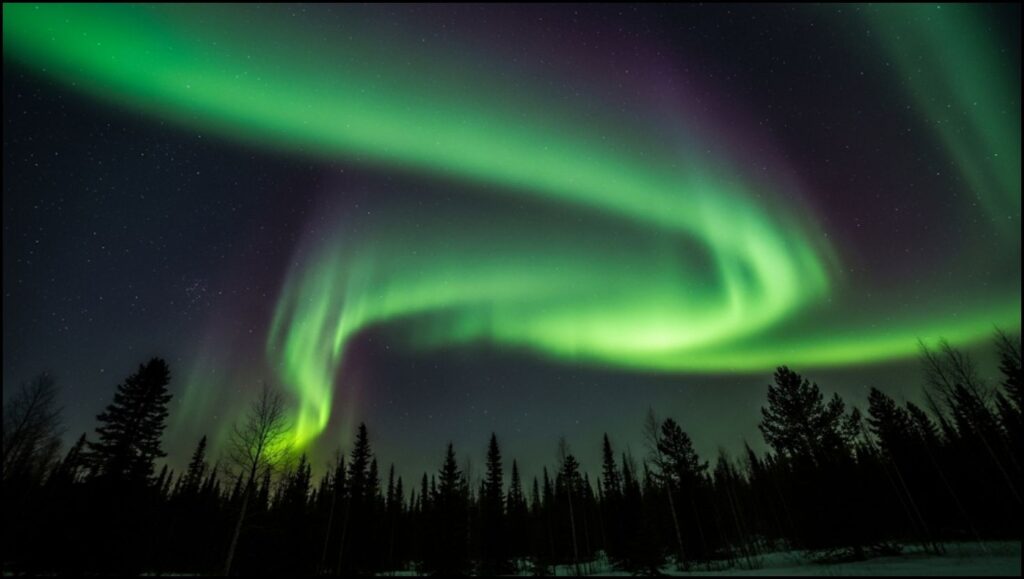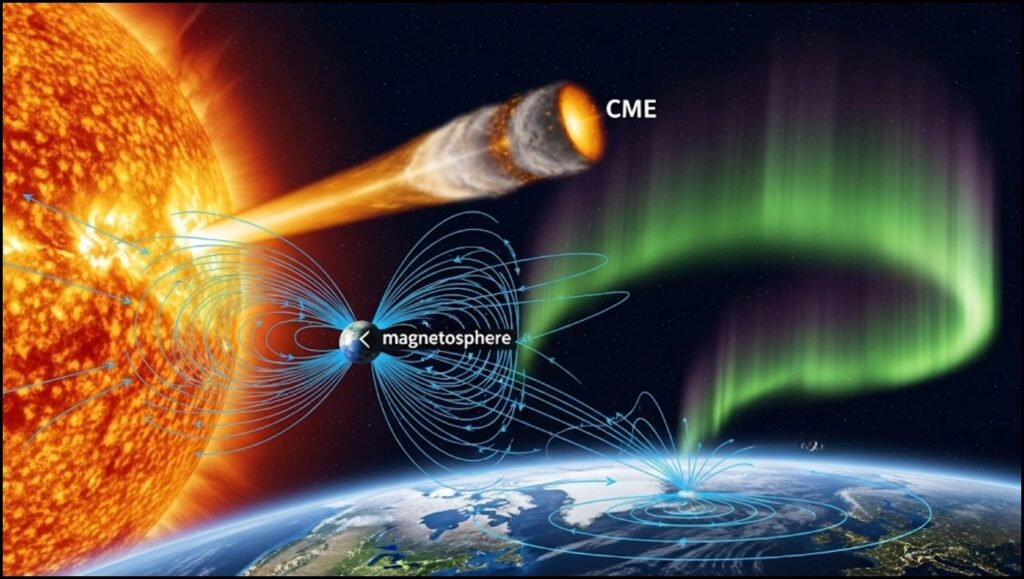
A powerful solar storm is expected to reach Earth tonight, creating the potential for the Northern Lights to be visible across parts of at least 14 northern-tier U.S. states. The National Oceanic and Atmospheric Administration (NOAA) has issued a G3 (Strong) Geomagnetic Storm Watch, signaling a rare opportunity for millions to witness the atmospheric spectacle, also known as the aurora borealis, far south of its typical arctic range.
Key Event Information
| Key Fact | Detail |
| Primary Cause | A Coronal Mass Ejection (CME) from the Sun is expected to impact Earth’s magnetic field. |
| Forecast | G3 (Strong) Geomagnetic Storm Watch in effect. |
| Potential Visibility | As far south as Pennsylvania, Iowa, and Oregon. |
| Best Viewing Time | Late tonight into the early morning hours, between 10 PM and 2 AM local time. |
The Science Behind Tonight’s Aurora Display
The anticipated light show is the result of a significant eruption from the Sun’s surface, known as a Coronal Mass Ejection (CME). A CME sends a massive cloud of charged solar particles hurtling through space. When this cloud collides with Earth’s magnetosphere—the protective magnetic shield surrounding our planet—it triggers a geomagnetic storm.
“Think of Earth’s magnetic field as a shield. When a CME hits, it’s like a powerful gust of wind rattling that shield,” said Dr. Michael Henderson, a space physicist at the Massachusetts Institute of Technology (MIT). “This interaction energizes particles already trapped in our magnetosphere. These energized particles then funnel down the magnetic field lines toward the poles and collide with atoms and molecules in our upper atmosphere.”
Those collisions release energy in the form of light, creating the dazzling, dancing curtains of the aurora borealis. The color of the aurora depends on which gas is being excited; oxygen typically produces green and red light, while nitrogen can create blue and purple hues.

Understanding the Geomagnetic Storm Scale
The intensity of a geomagnetic storm is measured on a scale from G1 (Minor) to G5 (Extreme). The current watch is for a G3 storm, which is considered strong.
“A G3 storm is significant enough to push the aurora oval southward over large parts of the United States,” stated a bulletin from NOAA’s Space Weather Prediction Center (SWPC), the government agency responsible for space weather forecasts. While G3 storms can potentially cause some issues with satellite operations and power grid voltage control, they are not expected to cause widespread disruptions for the general public.
Where and How to Watch the Northern Lights
Forecasters predict the Northern Lights could be visible, weather permitting, in a broad arc across the northern United States. The official forecast includes potential sightings in Maine, New Hampshire, Vermont, New York, Pennsylvania, Michigan, Wisconsin, Minnesota, Iowa, North Dakota, South Dakota, Montana, Idaho, and Washington.
For the best chance of seeing the aurora, experts offer several key recommendations:
- Escape City Lights: Light pollution from urban areas will wash out the faint glow of the aurora. Travel to a rural area with a clear, dark sky.
- Look North: The aurora typically appears on the northern horizon, especially for viewers at lower latitudes. Find a spot with an unobstructed view in that direction.
- Be Patient: The aurora can be sporadic, appearing in bursts that last for several minutes before fading away. Allow at least an hour of viewing time. Your eyes also need about 20-30 minutes to fully adapt to the darkness.
- Check the Weather: Clear skies are essential. Cloud cover will completely block the view.
“Your camera’s sensor is often more sensitive to the aurora’s light than the human eye,” noted Dr. Henderson. “If you think you might be seeing a faint, grayish cloud on the horizon, try taking a long-exposure photograph with your smartphone or camera. You might be surprised by the green glow that shows up.”
An Increasingly Active Sun
This powerful solar event is part of a larger trend. The Sun is currently in Solar Cycle 25, an approximately 11-year cycle of solar activity. This cycle is forecast to reach its peak, known as the “solar maximum,” sometime in late 2024 or mid-2025. During solar maximum, events like solar flares and CMEs become much more frequent and intense, leading to more frequent and impressive displays of the Northern Lights on Earth.
Tonight’s event offers a preview of what could become more common over the next year. As the Sun continues its ramp-up toward its cyclical peak, sky-watchers across the northern hemisphere may have more opportunities to witness one of nature’s most spectacular phenomena.
Annual Perseid Meteor Shower to Peak, Promising Dazzling Celestial Display
